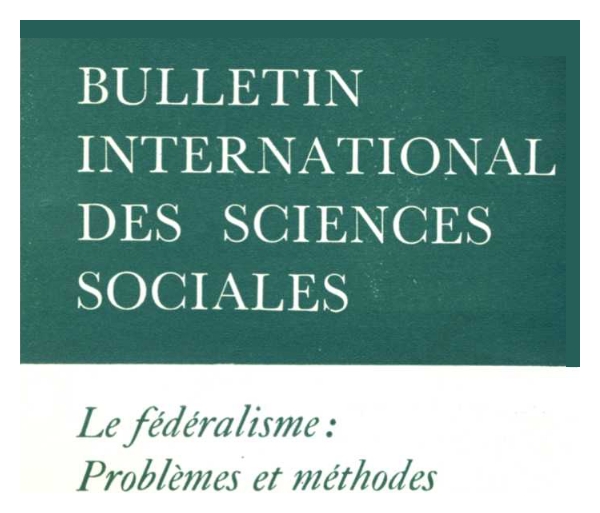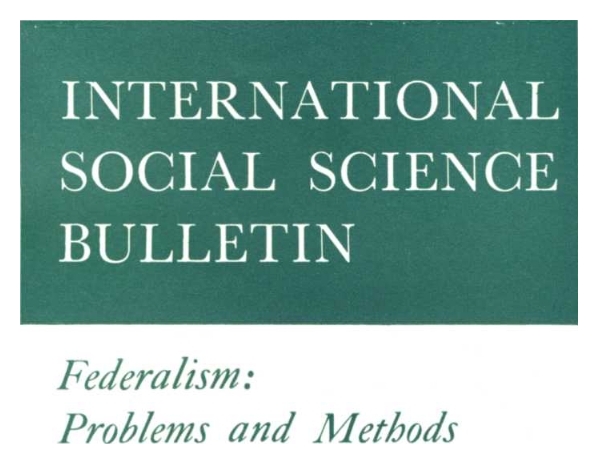After the end of WWII, the world began to be restructured into regional unions of the kind we see on the Gomberg map.
Download the issue in English.
Télécharger le numéro en français.
- The project of federated continents under a world government was revealed in this 1952 UNESCO journal.
|
Le thème de cette publication de l’UNESCO datant de 1952 est la manière de parvenir plus facilement au “fédéralisme”, c’est-à-dire à la fusion des États en régions qui seront placées sous l’autorité d’un gouvernement mondial planifié Peu après la Seconde Guerre mondiale, le processus avait déjà commencé, produisant la Communauté économique européenne, un exemple de la première étape de la transformation à long terme des nations indépendantes en unions politiques, un objectif clairement défini sur la carte de Gomberg de 1941-42. |
The theme of this 1952 UNESCO publication is how to more easily achieve “federalism”, i.e. the amalgamation of states into regions to be placed under the authority of a planned world government. Shortly after the Second World War, the process had already begun, producing the European Economic Community, an example of the first stage in the long-term transformation of independent nations into political unions, a goal clearly set out on the Gomberg map of 1941-42. |
|
L’« Introduction à une étude de l’évolution des sociétés fédérales » du professeur Jean RIVERO, qui ouvre le numéro, est longue, mais utile. Rivero procède à l’analyse et à la synthèse des articles rédigés par des auteurs qui espèrent trouver des moyens de défricher la voie vers la fusion politique des nations en régions. |
Professor Jean RIVERO’s “Introduction to a Study of the Developmentof Federal Societies” which leads the issue is long, but useful. Rivero proceeds to analyze and synthesize articles contributed by authors who hope to find ways to clear the road toward the political fusion of nations into regions. |
|
Jetons un coup d’œil à quelques extraits. Celui-ci est tiré du bas de la page 5, haut de la page 6. Il explique l’objectif fondamental de cette étude de l’UNESCO. |
Let’s look at some excerpts. This one is from the bottom of page 5, top of page 6. It explains the basic goal of this UNESCO study. |
|
|
|
Cela explique les approches adoptées par les auteurs des contributions : |
This explains the approaches adopted by the contributors: |
|
|
|
Le Canada serait un très mauvais exemple de fusion d’États souverains en régions politiques, comme l’aurait su le professeur Scott. F. R. Scott était professeur de droit à l’université McGill, où il est devenu doyen de la faculté de droit. Scott était également un socialiste proche du Royal Institute of International Affairs (RIIA), le siège financier du mondialisme. |
Canada would be a very bad example of the amalgamation of sovereign states into political regions, as Professor Scott would have known. F. R. Scott was Professor of Law at McGill University, where he became Dean of the Faculty of Law. Scott was also a socialist close to the Royal Institute of International Affairs (RIIA), the financial headquarters of globalism. |
|
Les colonies qui ont formé la Confédération n’ont jamais atteint le statut de nations indépendantes, contrairement à celles qui se sont rebellées contre l’Angleterre pour devenir les États-Unis. Les colonies canadiennes (ou nord-américaines britanniques) se sont fédéralisées, mais pas complètement, pour se protéger de l’assimilation par des entités plus grandes, qu’il s’agisse de l’entité américaine ou d’un Canada totalement unitaire. |
The colonies that formed Confederation never achieved the status of independent nations, unlike those that rebelled against England to become the United States. The Canadian (or British North American) colonies federalized, but not completely, to protect themselves from assimilation by larger entities, whether the American entity or a totally unitary Canada. |
| Le Canada est un État unitaire quasi-fédéral, le but étant, en 1867, de préserver l’autodétermination des colonies fondatrices dans toutes les questions relatives à leur existence culturelle et ethnique. Le professeur Scott, dans son “INTRODUCTION to the 1951 INDEX to PARLIAMENTARY DEBATES on the subject of the CONFEDERATION of the BRITISH NORTERICH AMERICAN PROVINCES” ; 3e session, 8e parlement provincial du Canada (1865) souligne que “[a]vant 1867  ;… Chaque province était une colonie britannique, sous la Couronne unique ; mais avec son propre gouvernement qui faisait ses propres lois nationales sur tous les sujets. Après l’Union, les provinces canadiennes ont perdu une grande partie de leur autonomie et sont devenues une partie d’un ensemble plus vaste appelé Canada Mais elles n’ont pas perdu leur identité Elles sont aussi des gouvernements, avec une large et importante sphère de compétence qui leur est réservée.” | Canada is a quasi-federal unitary state, the aim being, in 1867, to preserve the self-determination of the founding colonies in all matters relating to their cultural and ethnic existence. Professor Scott, in his “INTRODUCTION to the 1951 INDEX to PARLIAMENTARY DEBATES on the subject of the CONFEDERATION of the BRITISH NORTH AMERICAN PROVINCES;” 3rd session, 8th provincial parliament of Canada (1865) stressed that “[b]efore 1867 … Each province was a British colony, under the single Crown; but with its own government that made its own domestic laws on all matters. After Union, the Canadian provinces lost much of their autonomy, and became part of a larger whole called Canada. But they did not lose their identity. They, too, are governments, with a large and important sphere of jurisdiction reserved to them.” |
|
Aujourd’hui, en France, dans l’Union européenne, des jeunes sont persécutés, arrêtés sur leur lieu de travail, leur domicile et même la chambre de leurs enfants sont fouillés par la police, sur le simple soupçon qu’ils tentent de faire revivre des groupes patriotiques pour préserver l’identité française. C’est ce que le Québec obtiendra dans le système européen promu par le Parti Québécois : L’identité canadienne-française et les moyens de la préserver seront criminalisés par des tyrans. |
In France today, in the European Union, young people are persecuted, arrested in their workplaces, their homes and even their children’s bedrooms are searched by police, on the mere suspicion that they are trying to revive patriotic groups to preserve French identity. This is what Quebec will get in the European system promoted by the Parti Québécois: French Canadian identity, and the means to preserve it, will be criminalized by tyrants. |
|
Scott savait également que l’éclatement du Canada était inconstitutionnel. Dans une conférence donnée à McGill et enregistrée, Scott a déclaré : “Traduction : Les pères de l’État fédéral canadien, menés par John A. Macdonald, étaient en faveur d’une autorité centrale forte. Voyant comment les États-Unis, en 1861, s’étaient divisés en deux parties et avaient souffert d’une grave guerre civile à cause de la doctrine des droits des États (ou de l’autonomie provinciale, comme nous l’appellerions), ils voulaient s’assurer que ce pays ne se désintègrerait jamais“. |
Scott also knew that breaking up Canada was unconstitutional. In a recorded lecture at McGill, Scott said: “The Fathers of the Canadian federal state, led by John A. Macdonald, favored a strong central authority. Seeing how the United States in 1861 had broken into two parts, and suffered a grievous Civil War because of the doctrine of States’ Rights (or, provincial autonomy, as we would call it), they wanted to make sure that this country would never disintegrate”. |
|
(En fin de compte, cependant, le travail d’union régionale au Canada a commencé à être fait par une combinaison de terrorisme, gracieuseté de Fidel Castro, et la volonté insipide des Canadiens français de croire à la tromperie selon laquelle ils allaient être souverains). |
(In the end, however, the work of regional union in Canada began to be done by a combination of terrorism, courtesy of Fidel Castro, and the insipid willingness of French Canadians to believe the deception that they were going to be sovereign.) |
|
Deux votes (illégaux) ont eu lieu à ce jour au Québec pour convertir l’ensemble du Canada au système européen ; la population invitée à se prononcer sur “souveraineté-partenariat” ou “souveraineté-association” ne se doutaient pas qu’il s’agissait du contraire de la souveraineté. “Association” ou “partenariat” est un moyen de fusion et donc de perte d’indépendance. |
Two (illegal) votes have so far been held in Quebec to convert the whole of Canada to the European system; those invited to vote on “sovereignty-partnership” or “sovereignty-association” never suspected that this was the opposite of sovereignty. “Association” or “partnership” is a means of merger and thus of the loss of independence. |
|
On peut se demander si les colonies “américaines”, en se fédérant, s’attendaient à perdre leur propre identité, à être perdues dans une Union américaine législative de facto ou à être recolonisées par des immigrants. Peut-être n’avaient-elles pas non plus l’intention de disparaître lorsqu’elles se sont unies pour la première fois en 1776. |
It may be wondered whether the “American” colonies, in federating, ever expected to lose their own identities; to be lost in a de facto legislative American Union or to be recolonized by immigrants. Perhaps they, too, had no intention of disappearing when they first united in 1776. |
|
Vers un État mondial Dans le passage suivant, nous trouvons l’aveu que l’objectif, en 1952, était “l’unification totale du monde“, c’est-à-dire sa fédéralisation totale. Avec l’aveu supplémentaire que l’ONU elle-même était une tentative ; mais les progrès vers l’unification totale seraient mieux réalisés au coup par coup par le biais de fusions régionales. L’expression “coup par coup” est délicieuse parce qu’elle dit involontairement la vérité: toutes nos nations souffrent de coups d’État. Des coups d’État constitutionnels, parlementaires et territoriaux. Comment cela se fait-il ? Posez-vous la question. Votre constitution nationale autorise-t-elle sa propre élimination, son absorption par d’autres pays, pour former un État mondial homogène qui vous gouvernera à la place de vos propres lois ? |
Heading for a World State In the following passage, we find an admission that the goal, in 1952, was “the total unification of the world“, i.e. its total federalization. With the further admission that the UN itself was an attempt; but progress towards total unification would best be achieved piecemeal through regional mergers. The expression “coup par coup” is delightful because it unintentionally tells the truth: all our nations are suffering from coups d’état. Constitutional, parliamentary and territorial coups. How can this happen? Ask yourself this question. Does your national constitution authorize its own elimination, its absorption by other countries, to form a homogenous world state that will govern you in place of your own laws ? |
|
|
|
Ainsi, en 1952, l’Etat mondial était déjà en construction par le biais des régions. Le gouvernement mondial n’est donc pas une option pour l’avenir qui se réaliserait si nous disions “faisons-le”. C’est un projet fait par d’autres, il y a longtemps, toujours en cours, imposé sans notre consentement, pour lequel le monde est en train de se restructurer. Nous sommes au milieu de son déploiement. Nous vivons la réalisation de la carte de Gomberg de 1941-42 : l’imposition par étapes d’un Etat mondial, composé de régions fédérées et fédéralisées. Comme des fourmis sur une feuille, flottant sur l’eau, nous ne savons pas où nous allons. |
So, in 1952, the world state was already under construction by means of the regions. World government, then, is not an option for the future that would come about if we said “let’s do it”. It’s a project made by others, a long time ago, still in progress, imposed without our consent, for which the world is being restructured; we’re in the middle of its deployment. We are living the realization of the Gomberg map of 1941-42: the imposition by stages of a world state, made up of federalized and federated regions. Like ants on a leaf, floating on the water, we don’t know where we are going. |
À SUIVRE …
TO BE CONTINUED …

